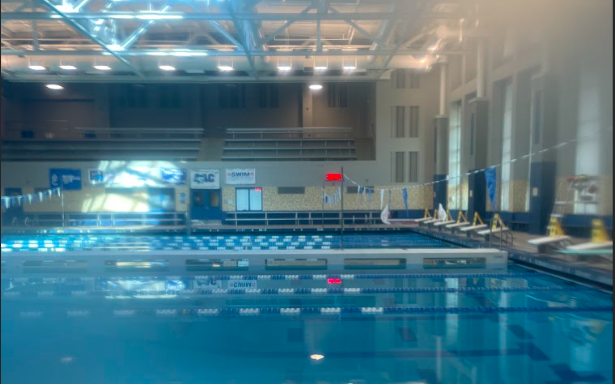The swimming unit and the effect it has on students
How eating disorders effect students participating in the swim unit of required health classes
The swimming unit is a two to three week unit in PE that happens in both ninth and tenth grade. Students spend those weeks learning to swim, tread water and other important life saving skills, including a CPR lesson. Those skills are very important, but learning those skills comes at the cost of an anxiety riddled unit where many students feel uncomfortable.
“It’s been about four years that I’ve struggled with it [eating disorders], off and on,” a sophomore girl at W-L who wished to remain anonymous said. “However, more consistently over the past two years.”
As the world suffered through the pandemic for two years, a study done by the National Health and Medical Research of Australia found that people with preexisting eating disorders (EDs) saw increased rates of binging, purging, and/or restricting food. According to the study, people who did not report any preexisting eating disorders restricted and/or binged at an increased rate. The study consisted of over 5,000 people, 180 of whom reported a past or current eating disorder.
“I think [with] the pandemic, we’ve seen it across the board, all ages [are] experiencing greater mental health issues,” Ms. Sara Fiorini, a PE teacher at the school, said. “Which we know can present themselves differently, so I do think [eating disorders are] something to take into consideration as I go into that unit with my group.”
Fiorini mentioned that the swimming unit is required by Arlington for both Health and PE 1 and Health and PE 2.
“I am aware that some students face [body dysmorphia]” Fiorini said. “In my experience not many, but definitely some.”
The swimming unit requires students to wear bathing suits during the class periods. This is a scenario which can make students with BDD or students who struggle with their body image uncomfortable, meaning the swimming unit can cause heightened anxiety.
“I was on a swim team, up until sixth grade,” the sophomore girl said. “ I remember being told and asked why I had a bit of a stomach. I felt more embarrassed than anything because I’d wear a swimsuit and it made me feel slower, it made me feel worse about myself and gave me an awful body image. So whenever we do the swim unit now, having [had] that happen repeatedly and [now] having to get into swimsuit in front of my classmates, it makes my anxiety super awful.”
Research done by Mayo Clinic states that BDD can be associated with depression, heightened social anxiety, obsessive compulsive disorder, and substance misuse. These issues can cause people with BDD to avoid social situations, seek constant reassurance from others, attempting to hide the parts, and having perfectionist tendencies. BDD causes the victim to hyperfixate and obsess over parts of their body they are not comfortable with. The most common features that people hyperfixate on are the face, hair, skin, vein appearance, muscle size, torso, other parts of the body that hold fat, breast size, and genitalia. Many times this leads to cosmetic surgeries and other remedies to try and “fix” their body. A study by Psychiatry Research (Psychiatry Res.) states more than 80% of teens with Body dysmorphic disorder (BDD) have suicidal ideation while 40% have actually attempted suicide. 94.3% of the teens studied said it caused moderate to extreme distress and all have higher rates of functional impairment, suicidal ideation, and suicide attempts that the adults who were also part of the study The study done by also found that adolescents diagnosed with BDD have a lifelong suicide rate of 22-24%.
“Yeah, it [the effect swim had on her suicidal ideations] was impartial, definitely , and it was also impartial to my own mental illness and my own depression and anxiety,” the sophomore girl said. “Having body dysmorphia and having more anxious situations like the swim unit or even gym class, [the swim unit] would definitely affect how I felt about myself and how invalidated I felt about myself.”
While the swimming unit is required, some accommodations can be made for students. Students can do the swimming unit while no one else is in the pool or the school allows students to wear whatever they want, like leggings, full body suits, etc. If the school is made aware of students’ BDD or eating disorders, these accommodations can be made, however, it is very difficult to get them.
“There are some teachers [that are] very forceful and kind of pick and choosy with students who are more athletic or thin or skinny,” the sophomore girl said. “I think students should have the option of doing the swim unit. Another thing they could do is if APS [continues to] require it, [it allows students to] get a swimming certification outside of school.”
The school does talk about EDs and BDD in the health curriculum, but it is not very thorough nor does it provide access to someone with greater expertise on the subject of BDD and EDs. Those specific issues are extremely sensitive and when not handled correctly, can have serious consequences. Eating disorders have one of the highest rates of suicide or attempted suicide and that should be taken into consideration when the school is teaching the students about these issues.
“I think [this] is definitely something where the school can pitch in,” the sophomore girl said. “While the counseling office usually has psychologists on hand, I think they should have an eating disorder specialist on hand. Someone who could maybe come in during the suicide unit and talk about how you’re not alone in this and there is no reason to invalidate your experience with Body Dysmorphia.”
There are other resources available to students at the school, such as the calm room. Getting help outside of school can also be very helpful. Seeing an eating disorder specialist or a therapist can really help with BDD. While the issue might not ever go away completely, getting help can be beneficial in learning to manage mental health.
“I think one of the biggest things, and we push this as soon as you enter the building, is developing a relationship with a trusted adult at the school,” Ms. Fiorini said. “Knowing what resources we have here such as the calm room [is important], I don’t know if every student knows that that is something we have here. I think clubs, a safe space to connect with other students after school who are going through the same things, [are helpful] to know that you aren’t alone.”
Sources:
https://www.ncbi.nlm.nih.gov/pmc/articles/PMC1592052/
What did you think about this story? Do you have any suggestions for improvements or other articles that you would like to see? Please use the contact form to communicate with us! (Keep all information school-appropriate)
https://docs.google.com/forms/d/e/1FAIpQLSeRYRWwLLzvs2rqwHSGdr-DQRvxhUSx9UcaXypXxnvVuCqwyA/viewform













